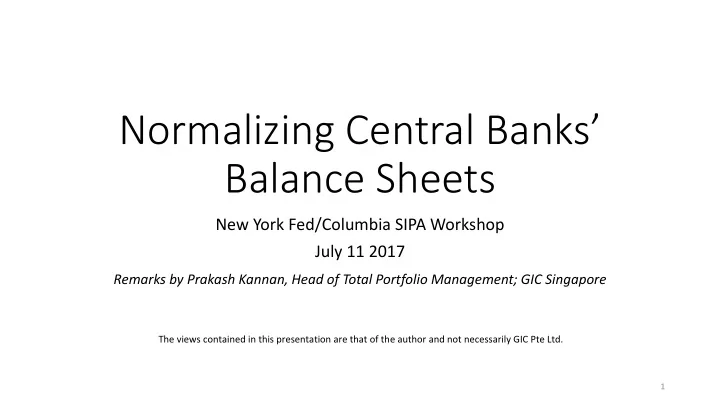

Normalizing Central Banks’ Balance Sheets New York Fed/Columbia SIPA Workshop July 11 2017 Remarks by Prakash Kannan, Head of Total Portfolio Management; GIC Singapore The views contained in this presentation are that of the author and not necessarily GIC Pte Ltd. 1
EM assets in the long run • Over a long horizon, the biggest driver of returns is the compounding of earnings • Stability of institutions and predictability of policy frameworks more important in the long run Ann. Return Snapshot Breakdown of EM LCY Index Returns: 24.0% 31/12/95 to 31/12/16 22.0% 20.0% 18.0% 16.0% 14.0% 12.0% 2.8% 1.2% 3.2% 10.0% 7.3% 8.0% 8.9% 6.0% 5.7% 4.0% 2.0% 0.0% -2.0% -4.0% -6.0% Earnings Dividends Valuation Total Return FX USD Return 2 Growth
Crises are a prevalent feature of EM • Price controls, leverage buildups, currency and maturity mismatches, thin markets and reliance on external financing introduce non-linearities in macro and market responses to shocks 3 Source: Claessens and Kose
Policy frameworks have been changing • Price flexibility provides some buffers • Investors are more discerning across EMs EM: Broad Money Growth Exchange Rate Classification %y/y 3yma 250% Broad money 200% 150% 100% 50% 0% 60 65 70 75 80 85 90 95 00 05 10 15 Source: Levy-Yeyati and Sturzenegger (2016) 4
Taper Tantrum 2013 • Impact was large, but did not lead to traditional “crises” • Two main drivers: 1. EM Fundamentals 2. Policy signalling channel Source: Federal reserve Bank of San Francisco (2014) 5
FX moves were in line with fundamentals • Vulnerability Index: • Current Account to GDP ratio • Gross Govt Debt to GDP • Average inflation over past 3 years • Ratio of external debt to exports • Ratio of FX reserves to GDP Source: Monetary Policy Report, February 2014 6
Policy signalling also mattered • Fed policy = f(r*, output gap, inflation vs target, “X” ) • Uncertainty over “ X ” factor: • Asset prices? • Financial stability? • Credit growth? • Change in preferences or reaction function? 7
Managing expectations 8
The situation today (1) • Vulnerabilities have fallen for “Fragile 5”, but risen elsewhere Current Account Balances for "Fragile Five“ Private Non-financial debt (% of GDP) 250 (% of GDP) 200 Turkey South Africa 150 Indonesia 100 India Brazil 50 -6 -5 -4 -3 -2 -1 0 0 (% for GDP) AR ID MX IN CO BR RU ZA TR PL CZ HU TH EM MY CL KR CN End-2016 May-2013 Q4 07 Taper tantrum Latest 9
The situation today (2) • EMs remain vulnerable to the global risk environment, DM interest rates, and the US dollar Source: Jon Anderson, EM Advisors 10
China remains a key risk factor for EMs Source: Jon Anderson, EM Advisors 11
Conclusion • EMs have undergone structural changes over the past 20 years that have resulted in more robust policy frameworks • But, EMs remain vulnerable to the global risk environment. Issue is not so much about interest rate increases per se but a spike in global risk aversion and a sharp moves in the USD • China remains a source of risk. Will it amplify or dampen Fed shocks? 12
Recommend
More recommend